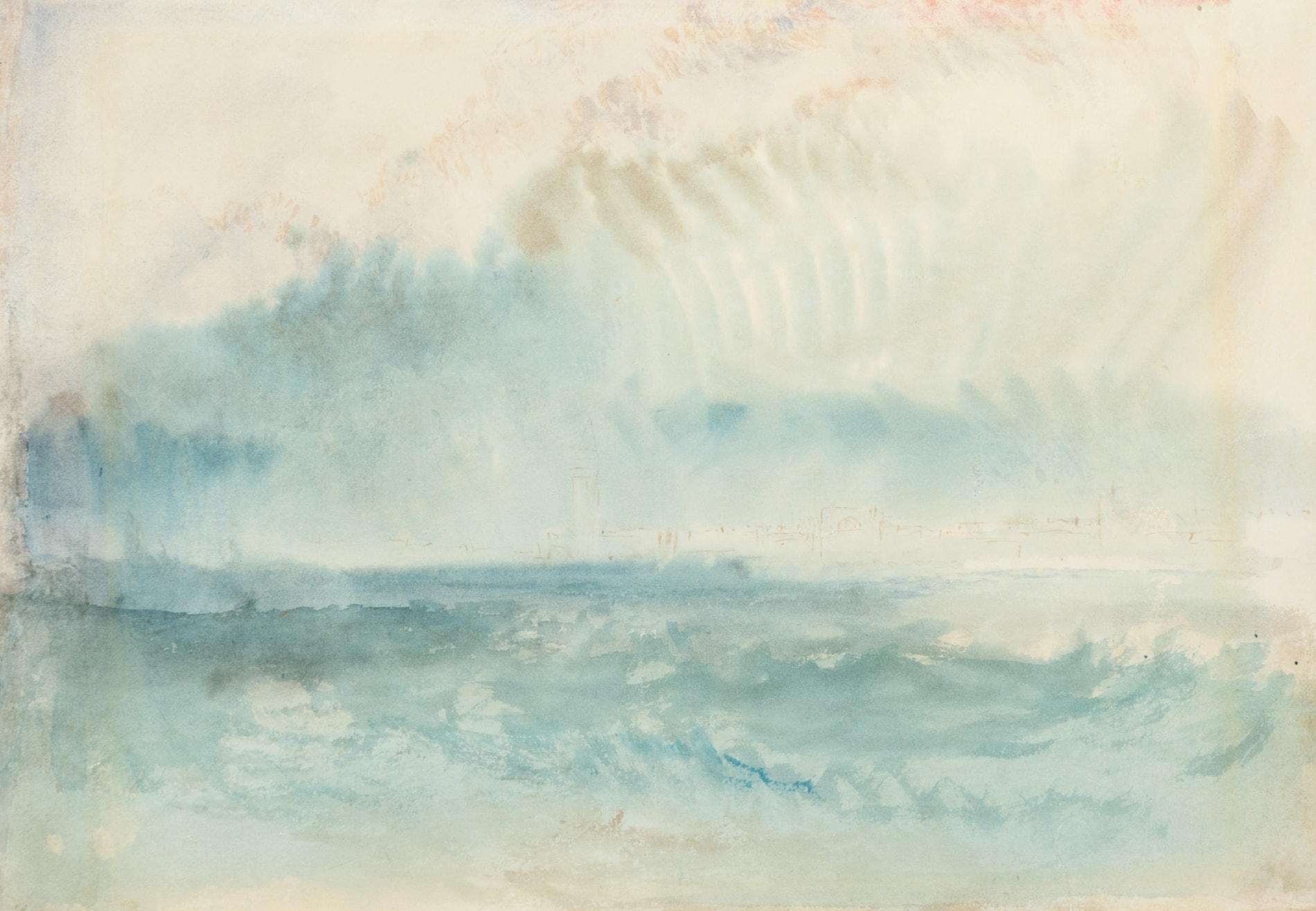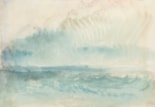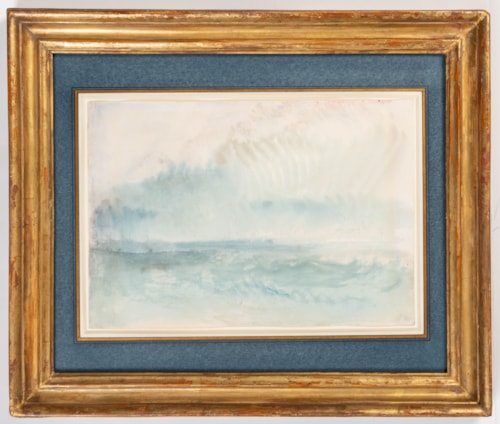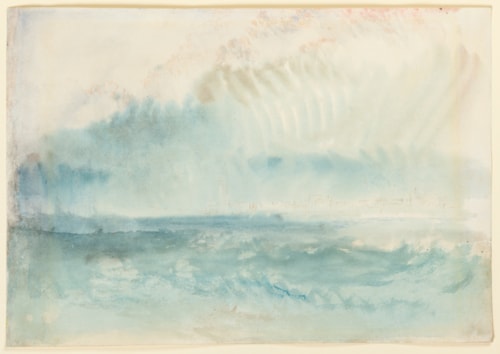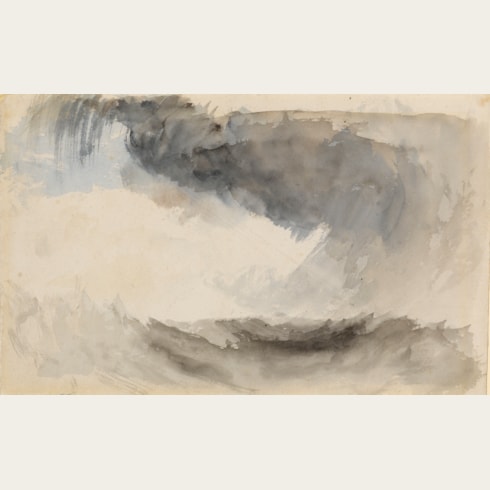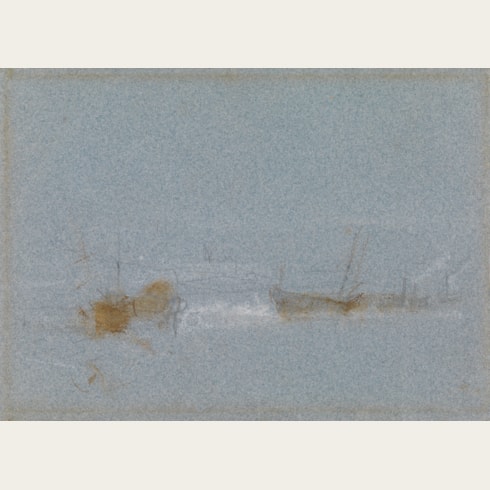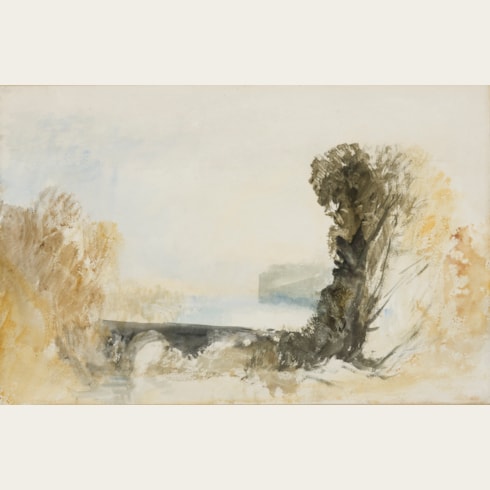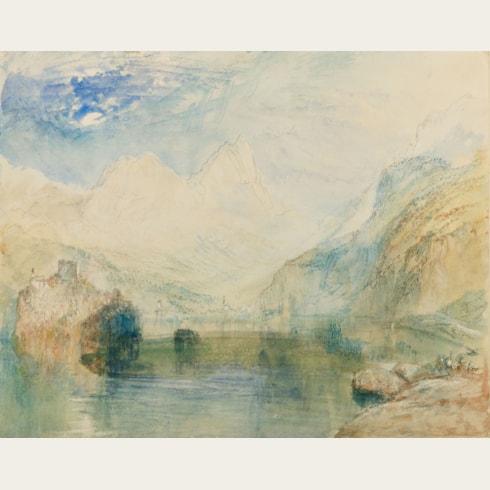Joseph Mallord William TURNER
(London 1775 - London 1851)
The Approach to Venice, or Venice, from the Lagoon
221 x 319 mm. (8 3/4 x 12 1/2 in.)
As the pioneering Turner scholar A. J. Finberg, writing in 1930, noted, ‘Though the number of Turner’s Venetian paintings and drawings is not very impressive when compared with the total of his enormous output, yet the works themselves, dealing as they do with a single and clearly-defined subject-matter, form a very interesting and important series. I believe this series, especially the water-colours, is more generally liked and admired at the present time than any other group of his works…There is something in Turner’s Venetian drawings and paintings which appeals with peculiar force to the artist, to the art-critic, and to the art-loving public of to-day.’ More recently, Martin Butlin has agreed that ‘Turner’s Venetian subjects, both in oil and watercolour, are now amongst the most sought after of his works.’
Another scholar, Luke Herrmann, has written of Turner’s third and final stay in Venice, in 1840, that ‘As well as making more rapid pencil notations…in three small sketchbooks,…he used larger roll-sketchbooks (which could be rolled up and kept in a pocket) to work in watercolours, very probably on the spot. These late Venetian watercolours, of which some two dozen were removed from the sketchbooks and sold during Turner’s lifetime, are among the artist’s supreme achievements in the medium of which he was such a complete and unrivalled master. Taken as a whole they provide the most engrossing survey of the unique character, atmosphere, and light of Venice; seen individually each one is an outstanding achievement in its own right.’
It appears that Turner used two identical soft-backed sketchbooks (known as roll-sketchbooks), both of which were purchased in London, on his 1840 tour to Venice. One of these – sometimes called the ‘Grand Canal and Giudecca’ sketchbook and containing twenty-one sheets, aptly described as ‘the most perfect, inventive and dream-like of Turner’s watercolours of Venice’ – is today part of the Turner Bequest at the Tate6. The Tate sketchbook consists of off-white Whatman paper in sheets each measuring approximately 222 x 322 mm., about half of which are watermarked 1834. A second, now dismembered roll-sketchbook of the same Whatman paper, known as the ‘Storm’ sketchbook, appears to have been broken up after Turner’s death. As has been noted, ‘It has sometimes wrongly been suggested that these leaves [from the ‘Storm’ sketchbook] were also part of TBCCCXV [the roll-sketchbook in the Turner Bequest]. However, few of Turner’s late roll sketchbooks contained more than twenty-four sheets, which argues strongly for a second sketchbook; as does the fact that these sheets became separated from the main group of Venetian studies in the Bequest.’ As Ian Warrell further notes, ‘The second of the Venetian roll sketchbooks contained a number of images, now widely dispersed, that were more fully developed than those in its companion [in the Tate].’ As the paper historian and analyst Peter Bower has confirmed, the present sheet is on the same paper as the ‘Grand Canal and Giudecca’ and ‘Storm’ sketchbooks, and must have come from the latter.
The late, ephemeral watercolours from the ‘Storm’ roll-sketchbook, amounting to at least twenty sheets and including the present example, were removed and sold to collectors through Turner’s agent and dealer Thomas Griffith, probably after the artist’s death. At least six of these watercolours were purchased by John Ruskin, of which three were later presented by him to the Ashmolean Museum in Oxford and three to the Fitzwilliam Museum in Cambridge. Other watercolours from the same ‘Storm’ sketchbook, all outside the Turner Bequest, are today in the collections of the National Gallery of Ireland in Dublin, the National Galleries of Scotland in Edinburgh, the Walker Art Gallery in Liverpool and the British Museum in London, as well as one in the Yale Center for British Art in New Haven, Connecticut. Only a handful are in private collections. It is likely that Turner hoped to gain commissions for finished watercolours based on the compositions in his Venetian sketchbooks - as was to be the case with a series of Swiss subjects executed a few years later - although in fact no finished Venetian watercolours from this late period are known.
As another scholar has noted of the Venice roll-sketchbooks, ‘With the group of watercolours from the roll sketchbook there are wide variations of style and mood, suggesting that Turner was deliberately exploring a range of responses to the city and its setting.’ It is sometimes difficult to determine the precise views depicted, since Turner’s intention was mainly to capture fleeting effects of light and colour. While the prominent bell tower in the centre of this composition may at first glance be thought to be the Campanile in the Piazza San Marco, the lack of any identifiable buildings near it, such as the Doge’s Palace or the church of Santa Maria della Salute, or indeed the entrance to the Grand Canal, would suggest that Turner was here depicting a different view altogether. Ian Warrell has suggested that the bell tower in the present sheet may be that of the church of San Francesco della Vigna, in the northeastern part of Venice. If so, then the large squarish building to its right in this watercolour could be the nearby church of San Lorenzo, with the great semi-circular Diocletian window dominating its façade, with Turner viewing the scene from a gondola on the lagoon, near the cemetery island of San Michele. As has been noted, ‘Turner developed a fascination for the city’s profile as seen from the broad expanses of adjacent water...even when restricting himself to the islands closest to the Bacino, Turner discovered vantage points that allowed him to frame the city in novel ways.’
Not long after Turner’s final visit to Venice in 1840, a railway bridge was constructed that connected the city with the mainland for the first time. As Warrell has pointed out, ‘Turner was fortunate in being among the last generation of travellers to experience Venice as a city that was still completely separate from the surrounding terra firma…the wide spaces of the lagoon were stimulating for Turner, liberating him from the constrictions of more contained outlooks within the city. Here sea and sky become as one and seem to extend without limits in a way that is timeless.’ Similarly, A. J. Finberg has noted of the late Venetian watercolours that ‘The parts of all these drawings in which Turner seems to take most interest are the sea and the sky…he finds more pleasure in them than in the architecture or the boats or figures. The surface of the water, in particular, is always struck in decisively, and its varying shades of blue and green evidently please him.’ This can be seen in this previously unpublished sheet as well as in a closely comparable watercolour of A Storm on the Lagoon in the British Museum, which comes from the same dismembered roll-sketchbook. As Warrell has written of the British Museum Storm on the Lagoon, in terms equally applicable to the present sheet, ‘[several] watercolours from the ‘Storm’ sketchbook chart the arrival of a late-afternoon squall…In the study now in the British Museum, a gondolier seeks shelter in the Grand Canal from the tossing waters of the Bacino. Whether fortuitously, or as a result of his observations, the opaque jade green that Turner uses in this work unerringly replicates what occurs when a storm aerates the Lagoon during a sudden downpour…It is as though, having returned to the [Hotel] Europa wet and dripping after being caught in the storm, he needed to work through the impressions that were still so vivid and fresh.’
Turner here used differing, subtle shades of blue-green watercolour to depict the waves in the foreground and the ribbed clouds above, with some pale red washes added towards the top of the sheet. Also evident here is another particular characteristic of the artist’s late Venetian watercolours; the use of red tones, applied with a fine pen or tip of a brush dipped in ink or watercolour, to delineate the topography of the city in the far distance, allowing architectural features to stand out against the overall bluish tonality of the water and sky. This is seen in several other watercolours from the ‘Storm’ sketchbook of 1840, such as Venice, The Grand Canal Looking Towards the Dogana in the British Museum and Venice, The Mouth of the Grand Canal in the Paul Mellon Collection at the Yale Center for British Art.
The first recorded owner of the present sheet was the art dealer and collector Thomas Griffith (1795-1868), who from the 1830s onwards acted as Turner’s agent. Griffith was trained as a lawyer but never practiced, despite being admitted to the Inner Temple in 1827. The same year he was entrusted with the sale of some of Turner’s finished watercolours for the Picturesque Views in England and Wales series, on which the artist worked between 1824 and 1838. A collector of watercolours, Griffith was also known as a supporter of artists, and Turner was one of several artists who presented him with a piece of silver plate in gratitude for his services in 1840. As an article in The Athenaeum noted of Griffith, ‘It is pleasant to find an amateur of pictures, whose fortune places him above the necessity of dealing, engaged in the difficult and troublesome task of smoothing the difficulties which occasionally arise between painters and their patrons, and to see the artists manifesting their grateful sense of such liberal aid.’ It was at Griffith’s home in 1840 that John Ruskin was first introduced to his hero Turner, and it was around the same time that Turner began to engage Griffith with handling the sales of some of his oil paintings. Griffith opened a gallery in London in 1845 and was instrumental in marketing Turner’s late Swiss watercolours of the early 1840s. Although named by the artist as an executor of his estate, Griffith chose to resign from this role after Turner’s death over the potential conflict with his activities as an art dealer.
Griffith owned at least one other of Turner’s 1840 Venetian watercolours from the ‘Storm’ sketchbook; a view of the Grand Canal with Santa Maria della Salute which is now in a private collection. At his death in 1868, his collection of watercolours, chalk drawings and pencil studies by Turner passed to his unmarried daughter Jemima Lardner Griffith, and were sold by her at auction in London in 1887. One of the major buyers at the sale was the Yorkshire industrialist Thomas Stuart Kennedy (1841-1894), who seems to have acquired the present sheet, through the dealers Agnew’s, either at, or very shortly after, the 1887 sale.
This atmospheric watercolour of Venice later entered the collection of the bridge engineer Haddon Clifford Adams (1898-1971), who was a noted collector of drawings, books, documents and ephemera by John Ruskin. (As Adams stated, in a letter of 1931, ‘collecting Ruskin is my one luxury.’). Much of Adams’s collection of Ruskiniana was bequeathed to the Ruskin Galleries at Bembridge School on the Isle of Wight and is now housed in the Ruskin Library at Lancaster University. Although Adams probably acquired the present sheet, sometime in the 1930s, as a work by Turner (and hence it was not included in his Ruskin gift to Bembridge), the correct attribution was forgotten soon after his death. Adams’s reputation as a collector of Ruskin’s works perhaps led his descendants to assume that this watercolour was by Ruskin. Its reappearance as a new addition to the corpus of Turner’s late Venetian watercolours, from the ‘Storm’ sketchbook broken up by Griffith, is therefore an event of considerable significance.
Provenance
By descent to his daughter, Jemima Lardner Griffith, Rochester, Kent
Probably her sale, London, Christie’s, 4 July 1887, lot 193 (‘Approach to Venice’, sold for 150 gns. to Agnew’s)
Thomas Agnew and Sons, London
Acquired from them on 6 July 1887 by Thomas Stuart Kennedy, Park Hill, Wetherby, Yorkshire
By descent to his wife Clara Thornton Kennedy, Harrogate, Yorkshire
Haddon C. Adams, Merton Park, London
Thence by descent.

